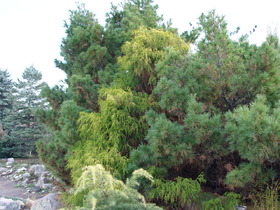
Denver Botanic Gardens
Gardens Navigator
March 2014 Walking Tour - Conifers

by Nick Daniel, Horticulturist
As spring is rapidly approaching and excitement is building for spring and summer flowers, let us not forget about a very important group of plants, the conifers. Conifers are simply 'plants which bear cones.' Almost all extant conifers are woody plants with most being trees as well as a few shrubby species. Conifers provide year round interest, structure, and texture to any garden setting. The stunning amount of shapes, textures, and sizes are sure to excite the senses as we wait for spring and summer flowers.
To get a true appreciation of our conifer collection at Denver Botanic Gardens, we begin the conifer tour on the east side of the UMB Bank Amphitheater in the Ponderosa Border. Pinus ponderosa, the ponderosa pine, beckons images of the Colorado foothills and mountains. As you approach the south end of Ponderosa Border you will encounter the Bristlecone Border. Pinus aristata, or the bristlecone pine, are native to Colorado and are stunningly tough trees. Ancient, wild populations can be viewed at our Mount Goliath site.
After enjoying Bristlecone Border, head to the northwest corner of the gardens to the Japanese Garden. Featured in the Japanese Garden are more of our native ponderosa pines that have been selected for their gnarled growth and are continually trained to maintain their aesthetic qualities in the Japanese tradition.
Once you have exited the Japanese Garden, head south down the path and into the Gates Montane Garden. The Gates Montane Garden evokes a sense of being in mountainous regions of Colorado. About half way down, on the west side of the path, is a giant sequoia, Sequoiadendron giganteum. No, the sequoia is not native to Colorado, but will slowly grow in Denver.
As you continue to head south through the Gates Montane Garden, you will arrive at the Rock Alpine Garden. The Rock Alpine Garden is packed with interesting conifers, some specimens of note being: Chamaecyparis pisifera 'Filifera Aurea', the Sawara cypress; Pinus strobus Nana Group, the dwarf white pine; a beautiful Picea abies Pendula Group, weeping Norway spruce; and a State Champion Cupressus bakeri or Siskiyou spruce. These specimens may all be found in the southwest corner of the garden.
As you head east out of the Rock Alpine Garden, you will run into the Dwarf Conifer Berm. These little trees have all been selected for the compact or dwarf habits, and provide structural elegance to any garden setting. After checking out the many dwarf species, head back north to Dryland Mesa.
If you approach Dryland Mesa from the south end, you will arrive at a staircase sitting neatly beneath one of our native Juniperus osteosperma, or Utah juniper. Continue up the stairs, and along the West side of the path is a beautiful stand of the single needle pine, or Pinus monophylla. Note that none of the plants in Dryland Mesa receive any supplemental irrigation, the only water they get is what falls naturally.
We have a truly unique conifer collection here at the Gardens--please be sure to enjoy them all scattered throughout our 24 acres.
|













